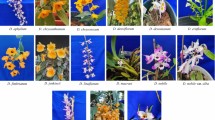Abstract
Random amplified polymorphic DNA (RAPD) analysis was used to determine the genetic relationships among seventeen species of theAcanthopanax species. The DNA isolated from the leaves of the samples was used as template in polymerase chain reaction (PCR) with twenty random decamer primers in order to distinguish plant subspecies at the level of their genomes. The RAPD patterns were compared by calculating pairwise distances using Dice similarity index, and produced to the genetic similarity dendrogram by unweighted pair-group method arithmetic averaged (UPGMA) analysis, showing three groups; a major cluster(twelve species), minor cluster (4 species) and single-clustering species. The results of RAPD were compatible with the morphological classification, as well as the chemotaxonomic classification of theAcanthopanax species. TheAcanthopanax species containing 3,4-seco-lupane type triterpene compounds in their leaves corresponded to the major cluster, another species having oleanane or normal lupane type constituents to minor clusters, and one species not containing triterpenoidal compound to single-cluster.
Similar content being viewed by others
References
Chang, S. Y., Yook, C. S., and Nohara, T., Two new lupane triterpene glycosides from leaves ofAcanthopanax koreanum.Chem. Pharm. Bull., 46, 163–165 (1998).
Chang, S. Y., Yook, C. S., and Nohara, T., Lupane-triterpene glycosides from leaves ofAcanthopanax koreanum.Phytochemistry, 50, 1369–1374 (1999).
Dettori, M. T. and Palobi, M. A., Identification ofFeijoa sellowiana Berg accessions by RAPD markers.Sci. Hortic., 86, 279–290 (2000).
Hosokawa, K., Minami, M., Kawahara, K., Nakamura, I., and Shibata, T., Discrimination among tree species of medicalScutellaria plants using RAPD markers.Planta Med., 66, 270–272 (2000).
Kasei, R., Matsumoto, K., Taniyasu, S., Tanaka, O., Kim, J. H., and Hahn, D. R., 3,4-Seco-lupane type triterpene glycosyl esters from Korean medicinal plant,Acanthopanax chiisanensis.Chem. Pharm. Bull., 34, 3284–3289 (1986).
Kitajima, J., Takamori, Y., and Tanaka, Y., Studies on the constituents ofAcanthopanax sciadophylloides Fr.et Sav. leaves.Yakukaku Zasshi, 109, 188–191 (1989).
Miyakoshi, M., Shirasuna, K., Hirai, Y., Shingu, K., Isoda, S., Shoji, J., Ida, Y., and Shimizu, T., Triterpenoid saponins ofAcanthopanax niponicus leaves.J. Nat. Prod., 62, 445–448 (1999).
Namba, T., Encyclopedia of Wakan-Yaku with color pictures. Hiokusa, Osaka, (1994).
Oh, H. J., Chang, S. Y., Yook, C. S., Yang, K. S., Park, S. Y., and Nohara, T., Two 3, 4-seco-lupane triterpenes from leaves ofAcanthopanax divaricatus var.albeofeuctus. Chem. Pharm. Bull., 48, 879–881 (2000)
Ohwi, J., Flora of Japan (rev. ed). Shibundo, Tokyo, (1972).
Park, S. Y., Chang, S. Y., Yook, C. S., and Nohara, T., New 3,4-secolupane-type triterpene glycosides fromAcanthopanax senticosus formainermis.J. Nat. Prod., 63, 1630–1633 (2000).
Paul, M. T., Tai, K. V., Kerry, K. S., and Raymond, J. S., Random amplified polymorphic DNA analysis of the phenetic relationships among world-wide accessions ofHydrilla verticillata.Aquat. Bot., 59, 217–223 (1997).
Sawada, H., Miyakoshi, M., Isoda, S., Ida, Y., and Shoji, J., Oleanane type triterpene glycosyl esters from leaves ofAcnathopanax sieboldianus.Phytochemistry, 34, 1117–1121 (1993)
Shaw, P. C. and But, P. P. H., Authentication ofPanax species and their adulterants by random-primed polymerase chain reaction.Planta Med., 61, 466–469 (1995).
Shao, C. J., Kasei, R., Xu, J. D., and Tanaka, O., Saponin from leaves ofAcanthopanax senticisus Harms., Ciwujia: Structures of ciwujianoside B, C1, C2, C3, C4, D1, D2, and E.Chem. Pharm. Bull., 36, 601–608 (1988).
Shao, C. J., Kasei, R., Xu, J. D., Tanaka, O., Saponin from leaves ofAcanthopanax senticisus Harms., Ciwujia. II. Structures of ciwujianoside A1, A2, A3, A4, and D3.Chem. Pharm. Bull., 37, 42–45 (1989)
Shirasuna, K., Miyakoshi, M., Mimoto, S., Isoda, S., Satoh, Y., Hirai, Y., Ida, Y., and Shoji, J., Lupane triterpene glycosyl esters from leaves ofAcanthopanax divaricatus.Phytochemistry, 45, 579–584 (1997)
Sneath, P. H. A. and Sokal, R. R., Numerical taxonomy: The principals and practice of numerical classification. Freeman, San Francisco, (1973).
Yook, C. S., Illustrated Book of Medicinal plants. Kyung-Won, Seoul, (1997).
Yook, C. S., Kim, I. L., Hahn, D. R., Nohara, T., and Chang, S. Y., A lupane-triterpene glycoside from leaves of twoAcanthopanax.Phytochemistry, 49, 839–843 (1998).
Author information
Authors and Affiliations
Corresponding author
Rights and permissions
About this article
Cite this article
Park, SY., Yook, CS., Nohara, T. et al. Random amplified polymorphic DNA analysis of genetic relationships amongAcanthopanax species. Arch Pharm Res 27, 1270–1274 (2004). https://doi.org/10.1007/BF02975893
Received:
Issue Date:
DOI: https://doi.org/10.1007/BF02975893




